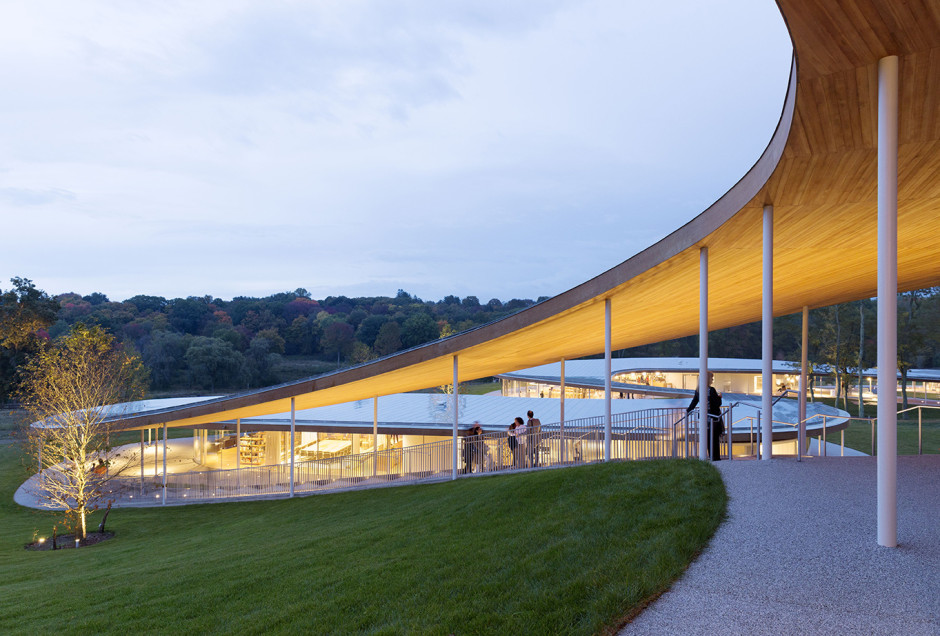
The United States—mother country of new religions—has always been prone to new forms of sacred architecture, in purpose as well as style. This has been demonstrated by Shaker meeting houses, Mormon tabernacles, Christian Science reading rooms, Scientology celebrity centers, and another very American manifestation: the evangelical Christian megachurch. This last phenomenon arose in Southern California with such examples as Brook Hawkins’s Angelus Temple of 1922–1923 in Los Angeles, a large circular arena with an unsupported concrete dome and twin radio towers that transmitted the ecstatic sermons of the faith healer Aimee Semple McPherson.
A later, more architecturally ambitious incarnation of the megachurch was Richard Neutra’s Garden Grove Community Church of 1959–1961 in Orange County, California, with its drive-in “sanctuary” where the faithful could receive the word of God from the evangelist Robert Schuller as they sat in their cars during his “Hour of Power” telecasts. Schuller followed the Neutra design by commissioning Philip Johnson and John Burgee to build the glitzy Crystal Cathedral of 1977–1981. But his ministry eventually went bankrupt, and in 2012 that huge mirror-glass structure was sold to the Catholic Church, which is turning it into an actual cathedral.
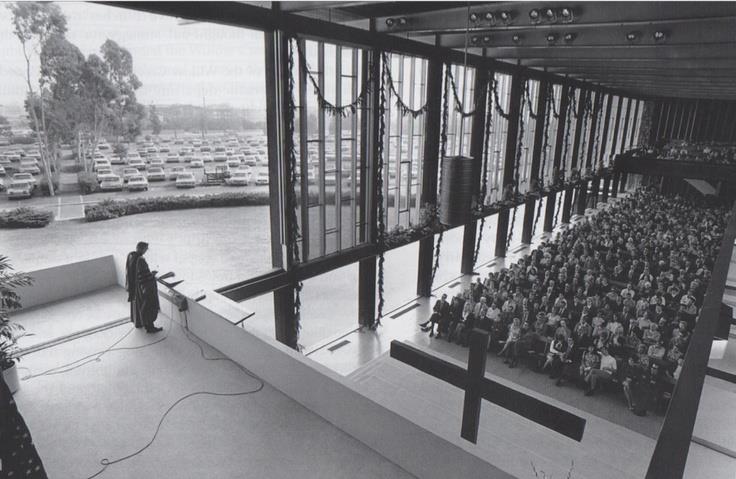
The spread of megachurches—there are now some 1,650 of them, each with 2,000 or more people attending weekly—is typified by their downplaying of religious symbolism and traditional ritual, with an emphasis instead on scripture, self-actualization, an all-pervasive informality, and a domestic rather than institutional atmosphere. In addition to worship services and Bible study, megachurches generally offer a host of secular activities (exercise classes, weight-loss programs, day care, job counseling, and the like) that make them service-oriented community centers more than havens of contemplative devotion.
Now we have perhaps the inevitable next step in this evolving concept: Grace Farms, a smaller, upscale version of the evangelical Christian megachurch, which opened to the public in New Canaan, Connecticut, in October. With structures designed by Kazuyo Sejima and Ryue Nishizawa of the Japanese office SANAA (which recently won the commission for the new National Gallery and Ludwig of Contemporary Art in Budapest) and landscaping by the American firm Olin, it exhibits far better taste and loftier cultural aspirations than the big-box spiritual supermarkets of the Sun Belt.
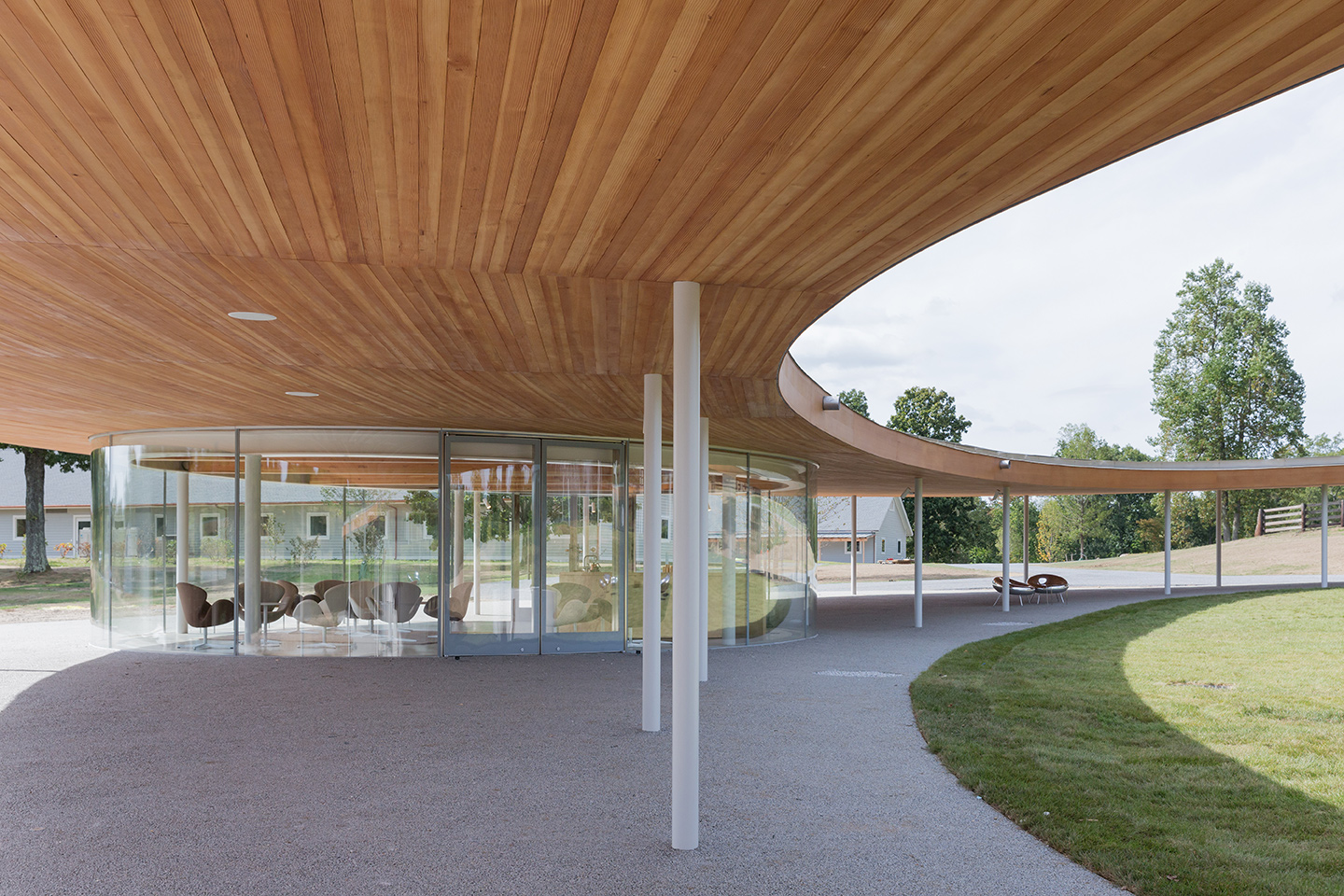
Set amid a verdant, gently rolling eighty-acre former horse farm, Grace Farms is described on its website as “a welcoming new place…for people to experience nature, encounter the arts, pursue justice, foster community, and explore faith.” That is quite an idealistic agenda, and only the most cynical are likely to see this impressive undertaking as anything but a potential boon to contemporary society.
In choosing SANAA, known for its barely-there Minimalist aesthetic, Grace Farms’ benefactors signaled their desire for an architectural presence that would nearly vanish. The firm’s 21st Century Museum of Contemporary Art in Kanazawa, Japan (1999–2004), a low, circular structure with glass walls, is similarly approachable from all directions and lacks a strongly emphasized main entrance. The New Canaan scheme—called the River for the way it seems to flow naturally down its hillside site—is as transparent as its Japanese precursor, but looks even more ethereal thanks to its thin, extruded, meandering form and astonishingly fine (though low-key) materials and details. Appropriately, it is not far from New Canaan’s most famous landmark, Philip Johnson’s Glass House of 1949–1950, another obvious prototype.
That there is considerable money behind this endeavor—$120 million is the estimated total cost of both the land and construction—stems in no small part from a taxation system very favorable to hedge funds, to say nothing of tax-exempt foundations and religious institutions. Grace Farms’ principal backers are Robert P. Prince, co-chief investment officer of Bridgewater Associates, the world’s largest hedge fund (Forbeshas estimated his income for one recent year at $70 million) and his wife, Sharon Prince, a former US president for an Icelandic outerwear company called 66 Degrees North, who serves as president of the Grace Farms Foundation, which was established in 2009. They and three other families founded the nondenominational Grace Community Church in 2001, and several of those friends are involved with both entities.
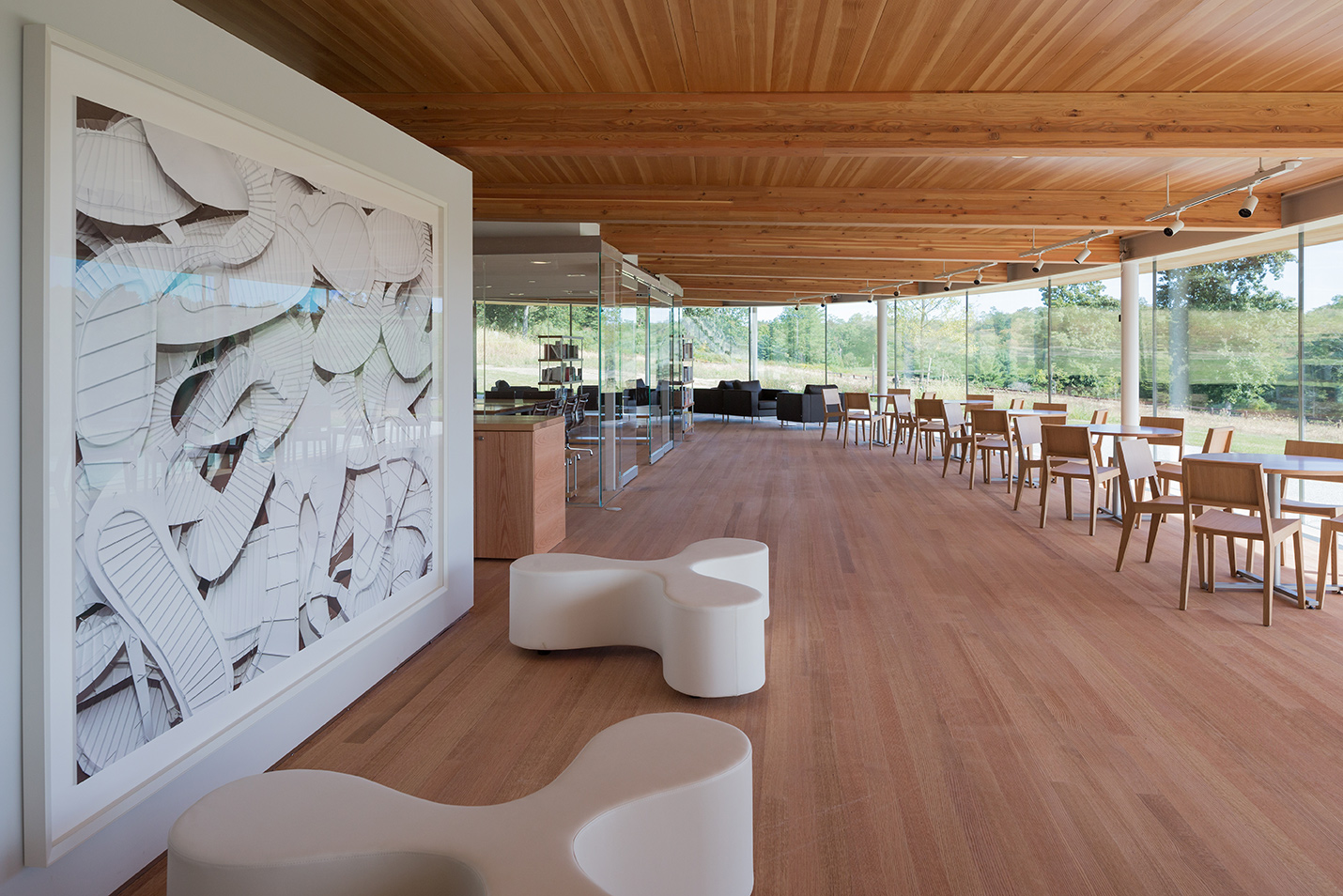
The connection between the two organizations is left vague by their adherents, who insist that Grace Farms is not a church. In keeping with this broader mission, the complex includes a library (which focuses on five themes—“Faith + Meaning,” “Art + Beauty,” “Justice + Ethics,” “Nature + Environment,” and “Community + Relationships”), a restaurant, tearoom, offices, and sunken indoor basketball court; there are also classrooms, meeting spaces, performance and art studios, and more offices in two nearby converted stables. At the River, it could well be said, in the words of the Randy Newman song, that “human kindness is overflowing.” However, the so-called Gold Coast of Fairfield County, which includes New Canaan, ranks sixth in the US in per-capita income and presumably is not in dire need of more libraries, sports facilities, or parkland.
The new complex also contains a seven-hundred-seat auditorium for religious services called the Sanctuary. This amphitheater-like configuration, wrapped with window-walls that afford panoramic views of the bucolic property (“Nature is the most expensive wallpaper,” Johnson jokingly said of similar vistas from inside his nearby retreat), is alternatively used for secular programs such as concerts and lectures, and thus is devoid of religious imagery. A simple cross is brought in for Sunday prayer meetings.
This space’s capacity is much smaller than a megachurch, yet soon after its opening Grace Farms welcomed 2,500 people on a single day, well within megachurch range. Although visitors thus far have included curious locals as well as the culturally aware (including art-collecting New York friends of ours who invited us to join them on their second visit there), many others are certain to be faith seekers attracted by the outreach of Grace Community Church’s senior pastor, Cliffe Knechtle. His evangelical Sunday morning “television ministry”—a show called Give Me an Answer—airs on a Connecticut station and radio channels in the high-income broadcast markets of New York City, San Francisco, and Seattle.
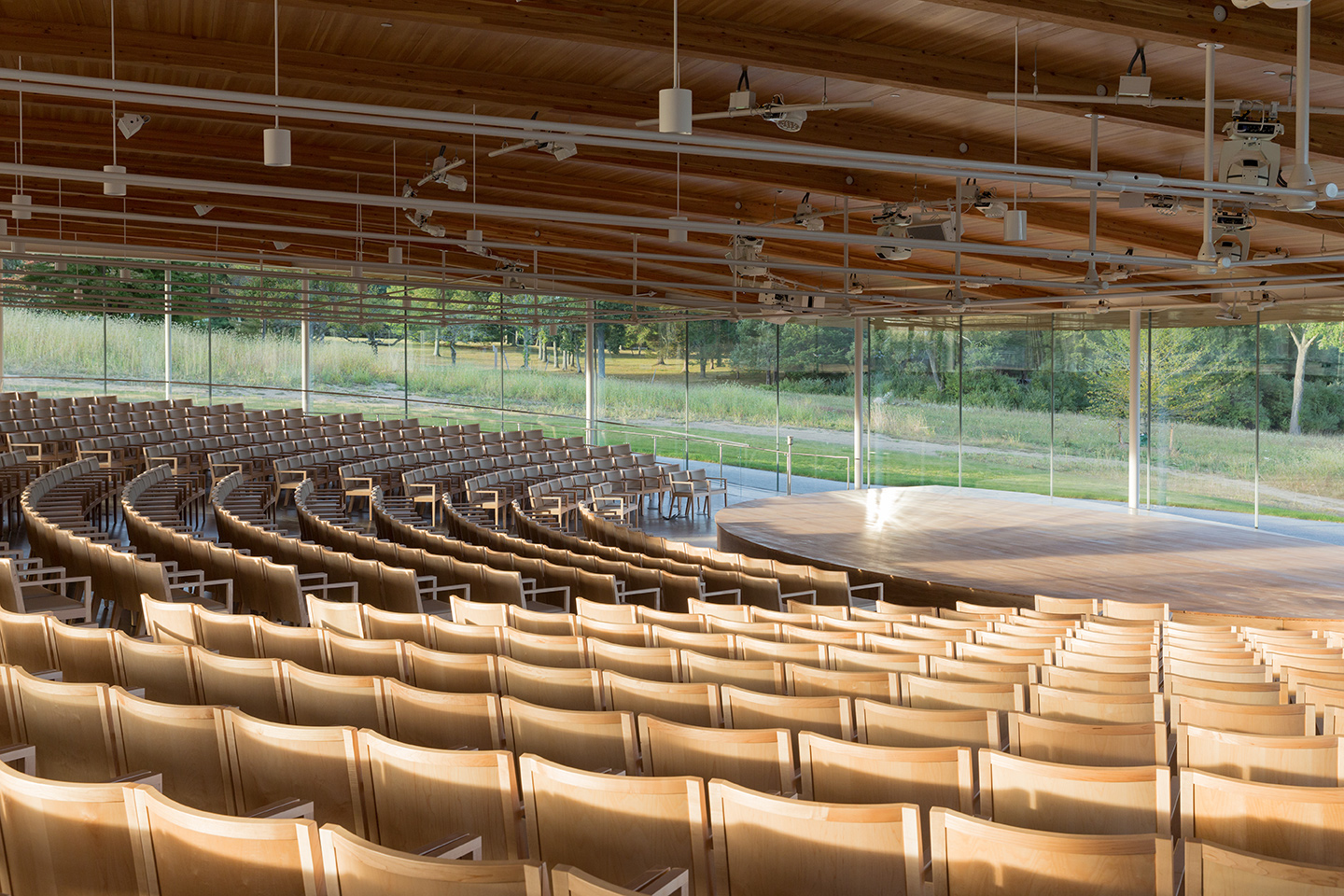
Beyond any quibbles of definition, Grace Farms is an exquisitely realized exercise in integrated architectural and landscape design. A series of five biomorphic, flat-roofed pavilions of different dimensions and joined by sinuous covered open-air walkways cascades down a voluptuously contoured terrain—which was doubtless given extra encouragement by bulldozers. Yet this reshaping has been so flawlessly accomplished that everything appears to be of geological origin.
Indeed, the composition conveys its elevated aims with a quiet perfectionism and elegant restraint that many will see as divinely inspired. Only Frank Lloyd Wright, Alvar Aalto, and Oscar Niemeyer among modern masters have melded the natural and the man-made as seamlessly as this. There are no bad views at the River, though during the winter it might prove difficult to proceed from one part of the ensemble to another, since the units do not connect internally and one must go outdoors to move between them.
It is ironic that despite these self-effacing design qualities—ego-loss on an environmental scale—Grace Farms is certain to become an architectural pilgrimage place. This is SANAA’s pinnacle achievement to date, owing in large measure to a budget big enough to ensure the high level of craftsmanship on which Minimalism so greatly depends. (The firm’s Rolex Learning Center of 2007–2010 in Lausanne, Switzerland, is marred by its far-from-perfect execution, surprising for a project commissioned by a Swiss watchmaking concern.)
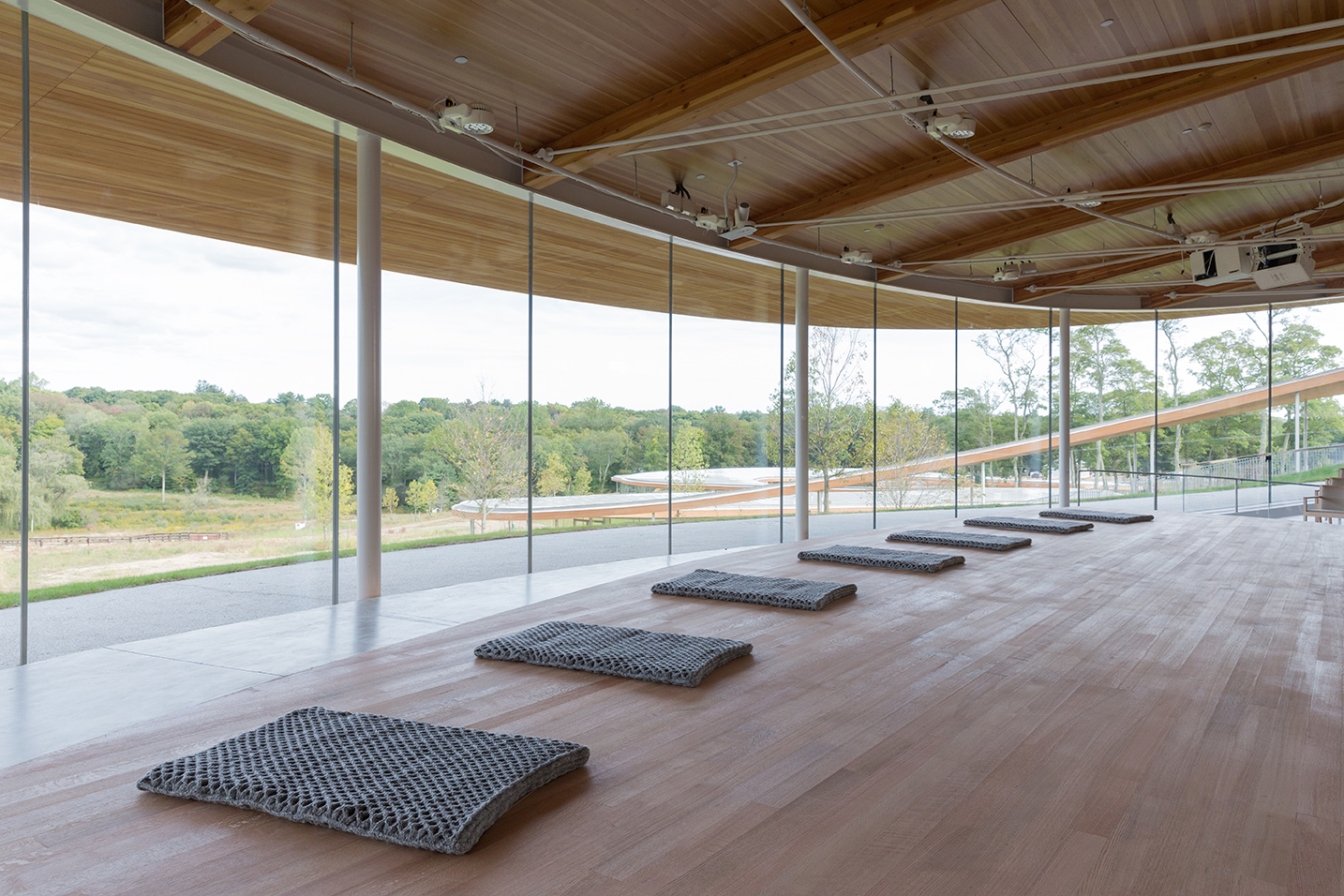
Grace Farms plans to present a wide range of cultural and educational programs free of charge to the public. It has thus far commissioned five site-specific artworks by major international figures. Among them are Olafur Eliasson (whose textile multiples, Mat for multidimensional prayers, are intended for use on the Sanctuary’s floor during what Grace Farms’s public relations firm describes as “an open unstructured quiet time,” if not outright prayer) and Thomas Demand (whose Farm 56, a large, collage-like photo of the project’s many study models, hangs in the library.) Most admirably, Grace Farms aims to address difficult social problems. Its “justice initiative” focuses on the rapid spread of sexual trafficking, subject of a program recently held there to bring together regional law enforcement officers and national security experts in order to devise practical strategies for direct action.
It is not yet clear how much these efforts will contribute as a force for good. The extent to which religion gives shape to Grace Farms’ overall ethos may or may not be of overriding significance. But for all the thoughtfulness that has gone into its creation, one wonders—especially during the pontificate of Pope Francis I, present-day apostle of the poor—whether the expenditure of such immense sums, in the midst of almost unimaginably concentrated wealth, is the true path to a state of grace for those who would alleviate the sufferings of mankind.
Niciun comentariu:
Trimiteți un comentariu